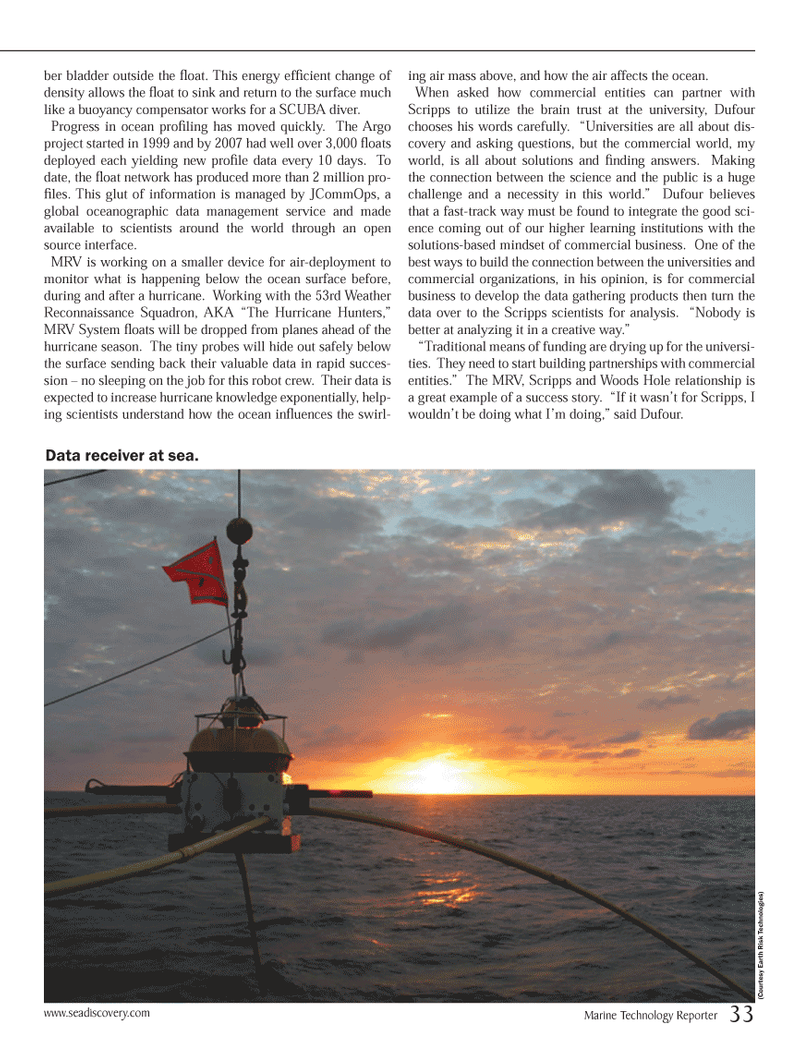
Page 33: of Marine Technology Magazine (October 2013)
Subsea Defense
Read this page in Pdf, Flash or Html5 edition of October 2013 Marine Technology Magazine
ber bladder outside the ß oat. This energy efÞ cient change of density allows the ß oat to sink and return to the surface much like a buoyancy compensator works for a SCUBA diver. Progress in ocean proÞ ling has moved quickly. The Argo project started in 1999 and by 2007 had well over 3,000 ß oats deployed each yielding new proÞ le data every 10 days. To date, the ß oat network has produced more than 2 million pro- Þ les. This glut of information is managed by JCommOps, a global oceanographic data management service and made available to scientists around the world through an open source interface. MRV is working on a smaller device for air-deployment to monitor what is happening below the ocean surface before, during and after a hurricane. Working with the 53rd Weather Reconnaissance Squadron, AKA ÒThe Hurricane Hunters,Ó MRV System ß oats will be dropped from planes ahead of the hurricane season. The tiny probes will hide out safely below the surface sending back their valuable data in rapid succes- sion Ð no sleeping on the job for this robot crew. Their data is expected to increase hurricane knowledge exponentially, help- ing scientists understand how the ocean inß uences the swirl- ing air mass above, and how the air affects the ocean. When asked how commercial entities can partner with Scripps to utilize the brain trust at the university, Dufour chooses his words carefully. ÒUniversities are all about dis- covery and asking questions, but the commercial world, my world, is all about solutions and Þ nding answers. Making the connection between the science and the public is a huge challenge and a necessity in this world.Ó Dufour believes that a fast-track way must be found to integrate the good sci- ence coming out of our higher learning institutions with the solutions-based mindset of commercial business. One of the best ways to build the connection between the universities and commercial organizations, in his opinion, is for commercial business to develop the data gathering products then turn the data over to the Scripps scientists for analysis. ÒNobody is better at analyzing it in a creative way.Ó ÒTraditional means of funding are drying up for the universi- ties. They need to start building partnerships with commercial entities.Ó The MRV, Scripps and Woods Hole relationship is a great example of a success story. ÒIf it wasnÕt for Scripps, I wouldnÕt be doing what IÕm doing,Ó said Dufour. Data receiver at sea. (Courtesy Earth Risk Technologies) Marine Technology Reporter 33www.seadiscovery.com MTR #8 (18-33).indd 33MTR #8 (18-33).indd 3310/15/2013 4:10:32 PM10/15/2013 4:10:32 PM

 32
32

 34
34
